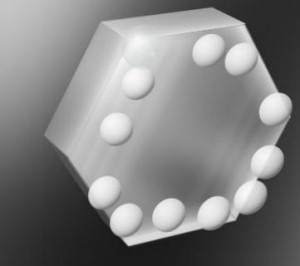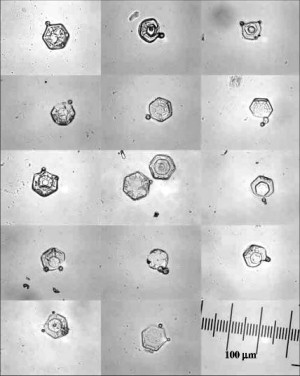Ice Crystal Riming
by Dr. Christopher Emersic
One of the first research projects using the new MICC facility involved investigating the riming efficiency of ice crystals.

Ice crystals in clouds grow in three main ways: growth by deposition of water molecules in the environmental vapour onto the crystal’s surface, riming, and also aggregation. Images showing the growth of ice crystals by vapour diffusion can be found in Fig 2. of the ice crystal light scattering page. The environmental conditions, such as temperature and ice supersaturation, govern the rate of growth and subsequent ice crystal shapes. Aggregation involves the sticking together of ice crystals to form long chains; further details of this are covered on the aggregation pages. Riming is a process involving the collection of supercooled water droplets onto the ice crystal surface. Supercooled water droplets are small droplets of water, a few microns in diameter, that are colder than 0°C but remain liquid (see nucleation section for further details of nucleation processes). As the crystals accrete these droplets, the droplets nucleate and freeze, adding to the ice mass of the crystal (Fig. 1).
However, crystals must reach a critical threshold size, and water droplets must be of sufficiently large diameter before riming occurs. Past research had indicated that riming occurred for columnar crystals once their width was between 50–90 µm, and plate crystals between 300–400 µm in diameter (Ono, 1969). Observations by Harimaya (1975) also showed that droplets needed to be larger than 10 µm.
Clouds of supercooled water droplets and ice crystals at various temperatures were generated in the MICC experiments, and glass slides were inserted into the cloud chamber to sample the ice crystals grown. These crystals were photographed and measured (Fig. 2), and whether riming had occurred was noted. It was found that in fact crystals can begin to rime at much smaller sizes than had previously been known or reported in the literature. For columnar ice crystals, a width of 30 µm and length of 60 µm was found to be the minimum threshold for evidence of riming; for plate crystals, a 60 µm minimum diameter was shown to be required.
These findings have important consequences in a number of areas of atmospheric science. The process of accretion removes droplets from clouds, and this modifies the spatial extent, spatial distribution, and lifetime of clouds (Pruppacher and Klett, 1997; Young, 1993). It also removes pollutants from the atmosphere (Finlayson-Pitts and Pitts, 2000), and plays a role in cloud electrification processes (MacGorman and Rust, 1998; Saunders et al. 2001; Saunders, 2008). (More about cloud charging can be found on our thunderstorm electrification page). These findings also show that models of ice crystal accretion of supercooled water droplets are not reliable for small ice crystal sizes. This research has been recently published in Geophysical Research Letters (Avila et al., 2009).
References
Avila, E. E., N. E. Castellano, C. P. R. Saunders, R. E. Bürgesser, and G. G. Aguirre Varela (2009), Initial stages of the riming process on ice crystals, Geophys. Res. Lett., 36, L09808, doi:10.1029/2009GL037723.
Finlayson-Pitts, B. J., and J. N. Pitts Jr. (2000), Chemistry of the Upper and Atmosphere, Academic, San Diego, Calif.
Harimaya, T. (1975), The riming properties of snow crystals, J. Meteorol. Soc. Jpn., 53, 384– 392.
MacGorman, D. R., and W. D. Rust (1998), The Electrical Nature of Storms, Oxford Univ. Press, New York.
Ono, A. (1969), The shape and riming properties of ice crystals in natural clouds, J. Atmos. Sci., 26, 138–147.
Pruppacher, H. R., and J. D. Klett (1997), Microphysics of Clouds and Precipitation, Atmos. Oceanogr. Sci. Libr., vol. 18, 2nd ed., 954 pp., Kluwer Acad., Dordrecht, Netherlands.
Saunders, C. P. R., S. L. Peck, G. G. Aguirre Varela, E. Avila, and N. Castellano (2001), A laboratory study of the influence of the water vapour and mixing on the charge transfer process during collisions between ice crystals and graupel, Atmos. Res., 58, 187–203.
Saunders, C. P. R. (2008), Charge separation mechanisms in clouds, Space Sci. Rev., 137, 335– 353.
Young, K. C. (1993), Microphysical Processes in Clouds, Oxford Univ. Press, New York.
